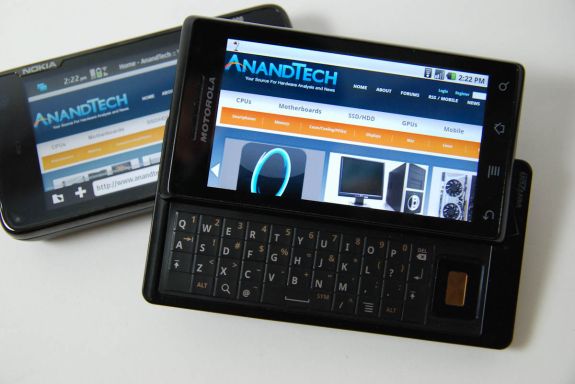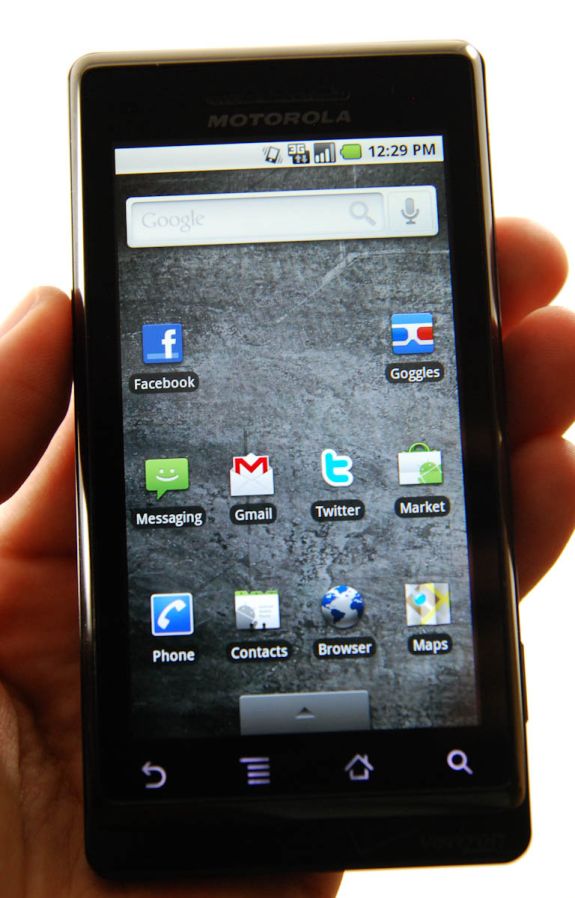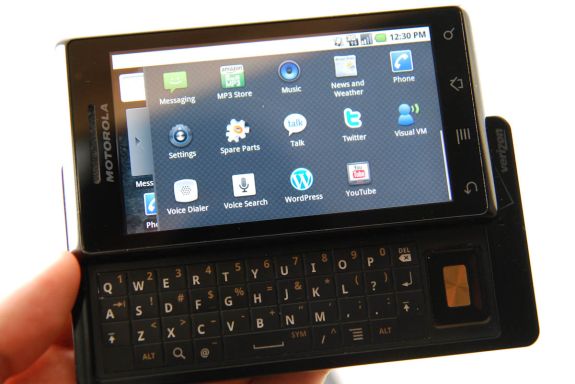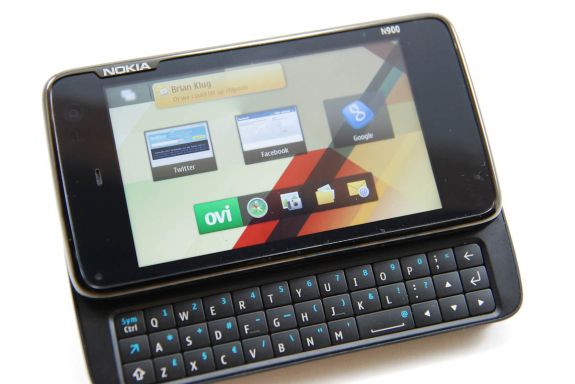Two OMAP 3430 Phones: Nokia N900 and Motorola Droid
by Brian Klug on June 10, 2010 9:29 PM EST- Posted in
- Smartphones
- N900
- Maemo
- Motorola Droid
- Droid
- MeeGo
- Android
- Mobile
The Motorola Droid continues to be the king of Android devices that include a hardware keyboard, and the smartphone which bore the Android flagship crown for some time before the Nexus One. Meanwhile, the Nokia N900 runs Maemo linux 5 - the operating system which - with polish and joint collaboration with intel - will soon emerge as MeeGo and power a host of Moorestown-packing devices. We're doing something a bit irregular by reviewing both phones in one article, but that's again because they're both running on the same Texas Instruments OMAP3 SoC. Let’s dive into both phones and see how they fare.
Motorola Droid - Still Does
As you probably already know, the Motorola Droid marked a turning point for Motorola, for Verizon’s smartphone lineup, and quite possibly a coming of age for Android as the first shipping smartphone with a mature 2.0 release. It wowed the market when it debuted Google Navigation, but puzzled everyone with its initial lack of multitouch support inside all official Google apps - despite packing a full multitouch digitizer.
Since launch, the Moto Droid has and will continue to see continual incremental updates. First, the Android 2.1 update added multitouch to the browser, gallery, and google maps, along with a number of other improvements brought alongside the entire platform update. At Google I/O 2010, we’ve now learned that the Moto Droid will see another update to Android 2.2 before year’s end - bringing a promised 2-5x speed boost to Android’s Dalvik virtual machine with a new JIT compiler, full in-browser Flash 10.1 in addition to Adobe Air support, cloud-to-device push APIs, OS-level WiFi tethering, and browser speed increases among other features.
It’s obvious that despite the recent release of the HTC Incredible, the Moto Droid will continue to hold a place in Verizon’s growing lineup of Android smartphones - and likely at a lower price point than HTC’s new flagship. Currently, Verizon is offering a buy one get one free Motorola Droid promption with purchase and a 2-year contract.
The Droid’s chief differentiating factor (other than likely continued lower price point) is the hardware keyboard. For so many, having a hardware keyboard is still a fundamentally important feature, though virtual keyboards aren’t as bad as they used to be - and they’re getting better. As an aside, it’s amazing how quickly ‘Big Red’ Verizon turned its lineup around and became host to so much Android hardware.
Nokia N900 - a ‘mobile computer’
There’s no doubt about it - the Nokia N900 is a unique beast. In fact, it’s that uniqueness which makes it a difficult sell for all but the most hardcore smartphone consumers, but also potentially the most powerful. The N900 is a landscape QWERTY slider with a 3.5” resistive LCD, front and back facing cameras, 3G HSPA for T-Mobile bands, and runs the debian derivative Maemo 5 OS.
I think it’s a fair argument to make that the N900 hasn’t received as much love state-side as it has abroad, or rightfully deserves. That’s probably due in part to only being sold unlocked with no subsidy, by no specific carrier (though it is targeted at T-Mobile for 3G support, and will work with 2.5G EDGE on AT&T), for $499 at retailers like Amazon. But it isn’t just Nokia grappling with that issue - Google recently learned how hard of a sell unsubsidized, bring your own plan schemes are with its Nexus One. In general, it’s hard to sell people on a $500+ smartphone if they can’t try the device beforehand, or get carrier support.
That aside, the N900 is likely the final evolution in a long chain of internet tablets designed by Nokia - starting with the N770 in 2005. Maemo linux has been as open as open source can be since the very beginning; its application manager started as little more than an APT frontend. If you prefer, it can even still be used that way from the XTerm terminal with an apt-get install. It’s a platform that’s been adorned and worshiped as the ultimate linux smartphone platform by hardcore *nix nerds ever since, and I intend to do it justice.














68 Comments
View All Comments
Affectionate-Bed-980 - Friday, June 11, 2010 - link
You talk about the display brightness and how nice it looks, but you need to mention gamut. In some tests the 3GS shows ~65% of gamut, while the Droid shows 102%. Nexus One is at 141%. I expect the Incredible to be around there, so while the colors look nice on AMOLED, you must remember it's over-saturated and inaccurate while the Droid is spot on at 102%.fabarati - Friday, June 11, 2010 - link
I think you've misunderstood what gamut means.When a screen is advertises as 98% of the Adobe sRGB Gamut, it means that the screen covers 98% of the colours defined by Adobe for that gamut..
If it says 141% of the Adobe sRGB gamut, it means that it covers more than that defined area. It doesn't mean that the colours are oversaturated. It also doesn't mean that it can display all the colours there is.
Read up on gamuts on wikipedia:
http://en.wikipedia.org/wiki/Gamut
Powerlurker - Friday, June 11, 2010 - link
On the other hand, I doubt that anyone is going to do color correction or some sort of display calibration on their smartphone, and since most companies set their displays to be somewhat saturated by default, I would guess that in practice the Incredible's AMOLED screen will be oversaturated compared to the Droid's LCD.Brian Klug - Friday, June 11, 2010 - link
So here's the problem - there's absolutely no way to measure it. Or at least, I haven't found an acceptable solution.Going off the display panel numbers seems extremely unrealistic for obvious reasons, but barring that there are other bigger problems.
1. Android uses 16-bit color in a lot of places because they're rendering them with 3D OpenGL compositing and compressed textures. One of the most glaring - and dare I say troubling - examples is right inside the gallery application. The gallery application in 2.0.1 was full 24-bit color, but in 2.1 Google contracted with Cooliris to develop a more flashy 3D gallery. Obviously, the limitations imposed by the GPU on different devices (and possibly even from the POV of what textures are supported) necessitated 16-bits per color. In practice, it just looks awful. Without even being nitpicky, I can notice lots of banding.
2. The AMOLED displays use the PenTile array, which also does a lot of dithering inherently - in fact, their pattern is essentially trying to get around Nyquist by being very creative with the human eye system, and this intermediate software layer of theirs. The consequence is that it ends up smoothing and dithering the 16-bits, making it really hard to see the banding, but it's still there. Pull up the color gradient images from the article and scrutinize the Incredible. There's no banding, but in person, you can stlll pick out dithering and a problem.
3. I still have no way of doing gamut testing on any mobile devices. So back when I started on the iPad article, I had a (relatively clever, I think) idea to use the calibration software through a 24-bit remote desktop session, tricking it into using any mobile device like a screen. This just doesn't work for reasons outside my understanding. I've done it on iPhone OS and Android, and for some reason the results are just complete bogus. So there's no way of really telling what the % gamut coverage of Adobe 1998 any of these things are. Moreover, since there's no way of loading a display profile on them, you're really stuck with whatever it shipped with anyways.
The sad state of things is that AMOLED "looks" brighter and more contrasty, but the color accuracy is just undoubtedly wrong. I mean, it's obvious to make that comparison when you're surrounded by calibrated IPS panels with Delta-E tracking under 1.0, you hold up any of the phones, and see a veritable library of differently hued photos.
I'm open to any suggestions you guys have for really measuring gamut. I mean, we could try being more manual and laboriously testing colors one by one (that's basically how I do brightness - white, black, and contrast) but, is it worth it?
KevinToon - Friday, June 11, 2010 - link
Shouldn't the speakerphone testing be done with the devices suspended off the desk??I know my phone sounds different if it's on a hard surface like a desk.
R3MF - Friday, June 11, 2010 - link
I have an n900, so thanks, good article.Found an interesting MeeGo article since you mentioned it:
http://jedibeeftrix.wordpress.com/2010/06/06/ultim...
medi01 - Friday, June 11, 2010 - link
May I ask why 3GS is missing from "side by side comparison"? Just an incident or you are THAT afraid of Mr Jobbs marketing's wrath?dtreader - Friday, June 11, 2010 - link
Wow! Just moments after finally placing my order for an N900 about eight hours ago (I've been lusting over this phone ever since it was just rumored to exist), I noticed this article on AT, with no comments having been posted to it yet. Cool, huh?I have a feeling there are many people like me....people that have been thinking about purchasing this incredible phone, but have been holding back for various reasons: for the price to come down a bit, to see how Nokia supported it with software updates, to find out about bugs and if they're being fixed, to feel comfortable about the future of Maemo on the N900 and, at this point, feeling comfortable about buying this phone even if Nokia comes out with something better in a few months time.
I've been depending daily on my flip phone/N800 tablet combination for a few years now, and have been dying to step up to the next level, even before I knew that would come in the form of the N900. A few months ago I looked at the Droid (currently I'm with Verizon), and lately considered the htc EVO on Sprint, but when you combine the current capabilities and the exciting future of the N900 (thanks to its truly open philosophy and dedicated enthusiast/developer base), I just couldn't wait any longer to get on board! T-Mobile 3.5G here I come!
Thanks for this article, Anandtech! You've been my main "source for hardware analysis and news" for over ten years now! :)
Go N900!!!
milli - Friday, June 11, 2010 - link
"From a performance perspective, the Motorola Droid's 550 MHz Cortex A8 simply isn't a match for the 1 GHz A8 in Snapdragon's Scorpion CPU ... "That should read: ... for the 1 GHz Scorpion CPU in the Snapdragon ...
There's no Cortex A8 in the Snapdragon.
Brian Klug - Friday, June 11, 2010 - link
That's being a bit semantic I think.Inside the Snapdragon is a Scorpion, which is Qualcomm's trade name for their hardened (1 GHz supporting) Cortex A8 CPU.
Cortex is the ARM Family, ARMv7-A is the family, and Cortex A8 is the fully qualified core name.
So really, either one is correct ;)
-Brian